22 Highlights From the Metropolitan Museum of Art. |
|
The Metropolitan Museum of Art in New
York recently released a collection of 400,000 high-resolution images,
each of a unique and beautiful piece. This means that I can share with
you some of the most amazing things shown at this "Cultural Mecca", and
you didn't even need to pay admission fees! The level of detail on some
of these pieces is just astounding:
Grand Pianoforte – 1840, London - United Kingdom |
 |
|
This
grand piano is unsurpassed in elegance and iconographic complexity. The
hammers are covered with felt and the strings of the top twenty-six
notes pass through a perforated brass bar, that secures them against the
hammers’ strong blows. Longitudinal steel bars reinforce the
open-bottomed case and all this makes for a sound as beautiful as the
piano itself. |
|
Celestial globe with clockwork –1579, Austrian - Vienna |
 |
|
This
globe was made by Gerhard Emmoser, imperial clockmaker from 1566 until
his death in 1584. The movement, which has been extensively rebuilt,
rotated in the celestial sphere and drove a small image of the sun along
its path. The hour was indicated on a dial mounted at the top of the
globe’s axis, and the day of the year appeared on a calendar rotating in
the horizontal ring. |
|
The Triumph of Fame - 1502–4, Brussels |
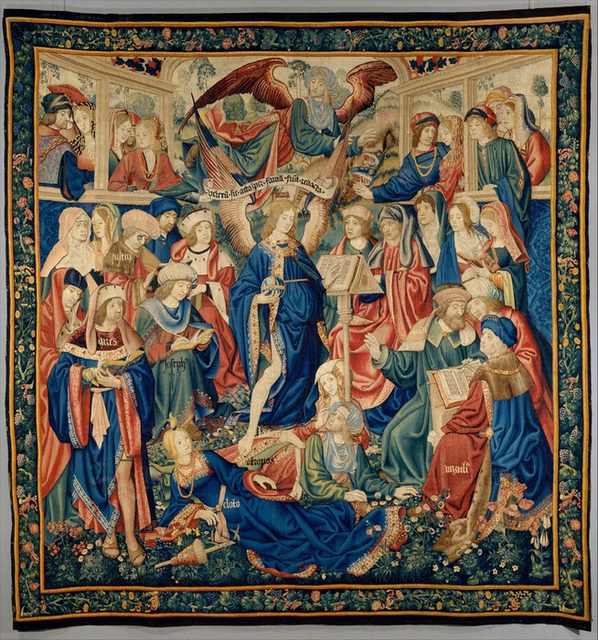 |
|
One
of the finest early Renaissance tapestries known, this piece is
extraordinary for its condition, color, and harmonious composition. Fame
is shown standing and reading at a lectern (ancient reading desk),
surrounded by writers whose works immortalized the deeds of the
ancients. His triumph over death is represented by the three Fates
beneath his feet. |
|
The Rocky Mountains by Albert Bierstadt – 1863 |
 |
| This painting is the first major work resulting from Albert Bierstadt's first trip to the West. In early 1859 he accompanied a government expedition to Nebraska. By summer, the party had reached the Wind River Range of the Rocky Mountains, now known as Wyoming. It was completed in 1863, exhibited to great acclaim, and purchased in 1865 for the then-astounding sum of $25,000. Needless to say it's worth a lot more today. |
|
Burgonet helmet – 1543, Milam- Italy |
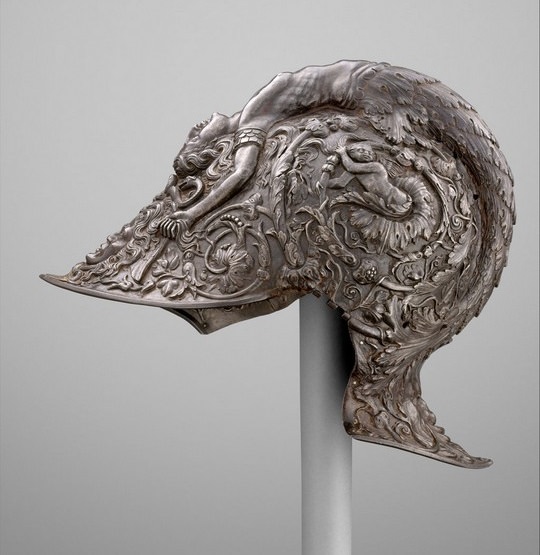 |
|
This
metalwork masterpiece was made by Filippo Negroli, whose embossed armor
was praised by sixteenth-century writers as “miraculous” and deserving
“immortal merit.” Formed of one plate of steel and painted to look like
bronze, the bowl is full of motifs inspired by classical art. The main
feature of the helmet is a graceful siren, holding a grimacing head of
Medusa by the hair. |
|
Ceramic Horn – late 18th - early 19th century, France |
 |
|
This
hunting horn is made of glazed pottery and was intended for decorative
display and not actual use. It bears an unidentified coat of arms so
little else is known about the true origin of this artwork. |
|
Ceramic Stove –1685, Switzerland |
 |
|
This
colorful ceramic stove was made for the paneled room in the Schlössli
(Little Castle), a manor house built in 1682. Stoves were common in
alpine regions, where the bitter cold of winter was unrelieved for
months at a time. They provided continuous heat while the enclosed fire
both conserved wood fuel, and removed the dangers of smoke and sparks
made by open fires. |
|
King Sahure and a Nome God - 2458–2446 B.C., Egypt |
 |
|
This
is the only preserved three-dimensional representation of Sahure, the
second ruler of the 5th dynasty. The deity is the smaller figure which
offers the king an ankh, a hieroglyph meaning “life”, with his left
hand. |
|
Bracelet with Agathodaimon - 1st century B.C.–A.D. 1st century, Egypt
|
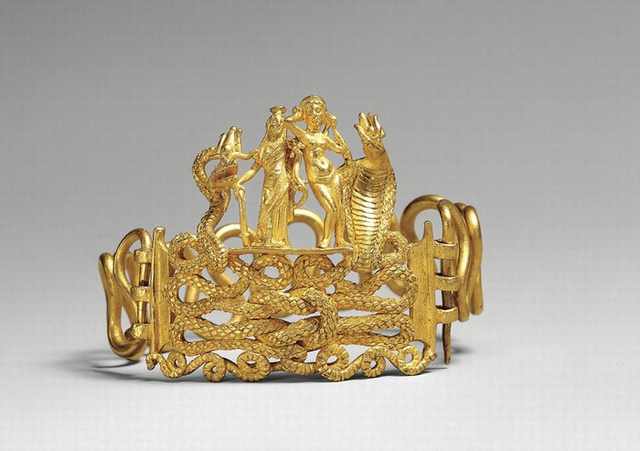 |
|
This
golden bracelet features talismans of fertility and good fortune in the
form of two snakes. The snake on the left represents Agathodaimon, and
the cobra on the right Terenouthis, two agrarian/fertility deities
associated with Serapis and Isis, respectively. On the platform between
the snake heads are the two goddesses, Isis-Tyche (or Isis-Fortuna), a
deity closely associated with Alexandria, and the nude Aphrodite, the
Greek goddess of love. |
|
Marble column - 300 B.C., Greece
|
 |
|
This
column was once over fifty-eight feet (17.6 meters) high in its
original location at the Temple of Artemis. The delicate carving on the
capital are unique among extant capitals from the temple, and the torus
(foliated base), with its vegetal scale-like pattern, is also
exceptionally elaborate. The column was probably one of a few column
pairs, each with its own design. |
|
Pair of Flintlock Pistols – 1786, Russia |
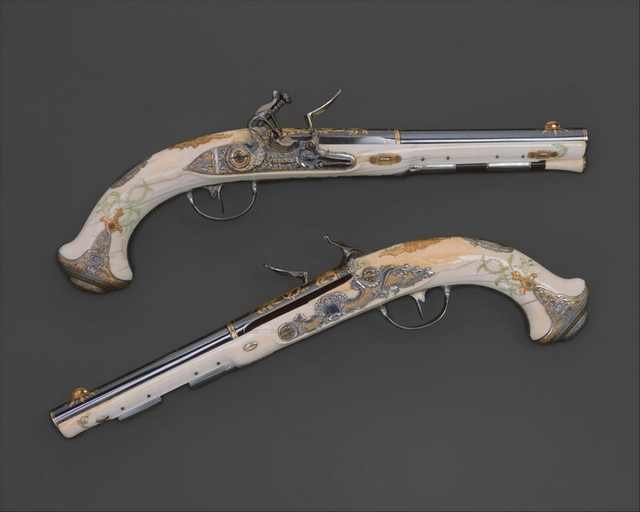 |
|
These
pistols were made for Empress Catherine the Great (reigned 1762–96).
They were later given to her favorite, Prince Stanislas August
Poniatowski (1732–1798), whom she backed as king of Poland. Firearms
with ivory stocks, generally out of fashion in western Europe by the
eighteenth century, were in vogue in the ostentatious Russian court
during the last quarter of the century. |
|
Beaker (“Monkey Cup”) - 1425–50, Netherlands |
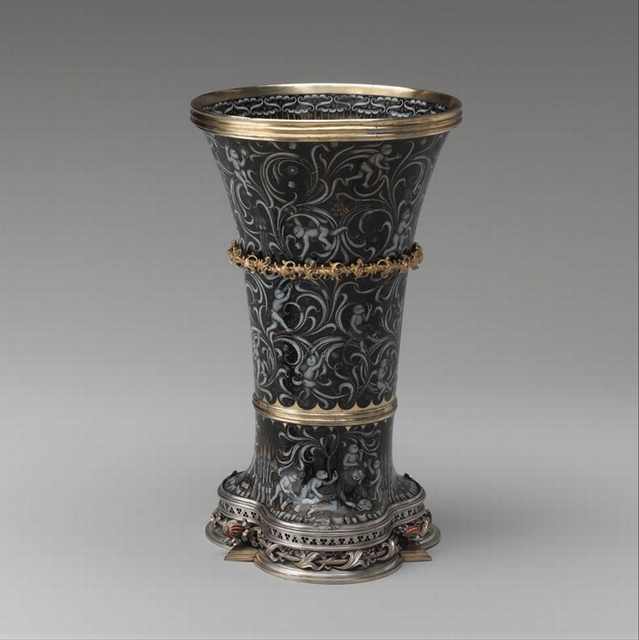 |
|
One
of the finest surviving examples of medieval enamel, this beaker
illustrates a popular legend about the folly of man. The unusual
grisaille (shades of gray) enamel technique is found on several other
surviving objects, all of which are associated with the royal courts of
Burgundy. |
|
Secretary bookcase - 1830, New York - United States |
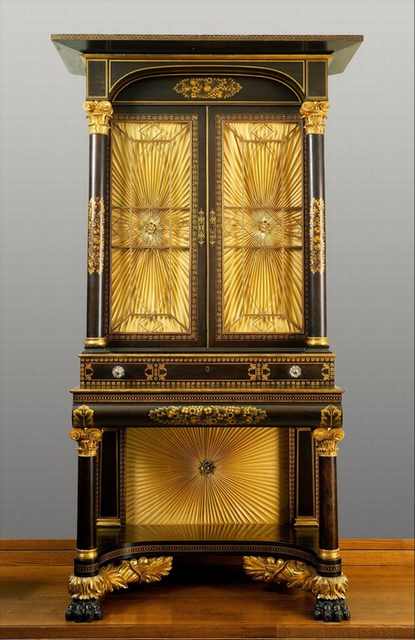 |
|
Aside
from its obvious decorative appeal, this classic piece of American
furniture served a practical function as well. The front molding pulls
out to reveal a writing surface flanked by compartments for ink. The
drawers and shelves above provided storage space for papers, letters,
and books. |
|
Wedding ensemble - 1864, France |
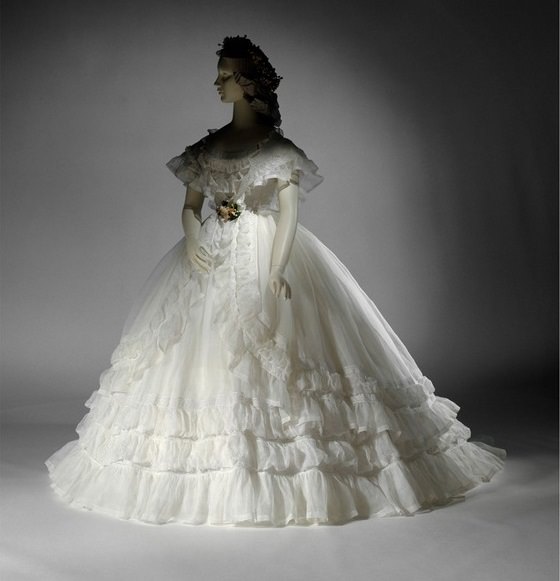 |
|
A rounded shoulder line that enhanced the length of the neck was the dominant fashion for most of the nineteenth century in France. The open neckline is apparent in this wedding dress and the under bodice of this summer gown. |
|
Cypresses by Vincent van Gogh - 1889 |
 |
|
Cypresses
was painted in late June 1889, shortly after Van Gogh began his stay at
the asylum in Saint-Rémy. The scene, which he found “beautiful as
regards lines and proportions, like an Egyptian obelisk,” both
captivated and challenged him. |
|
Dagger with Zoomorphic Hilt - second half 16th century, India |
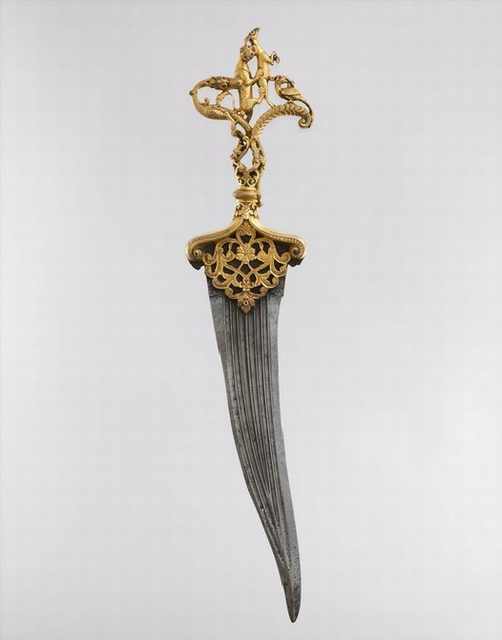 |
|
Portraits
of Sultan ‘Ali ‘Adil Shah of Bijapur (1558–80) show him wearing daggers
such as this one with zoomorphic hilts. This ruby studded hilt is
shaped like a dragon, whose tail wraps around the grip. The dragon is
attacking a lion, which in turn attacks a deer. The deer is holding a
parrot-like bird with a snake in its beak. |
|
Ewer - 1573–1620, London - United Kingdom
|
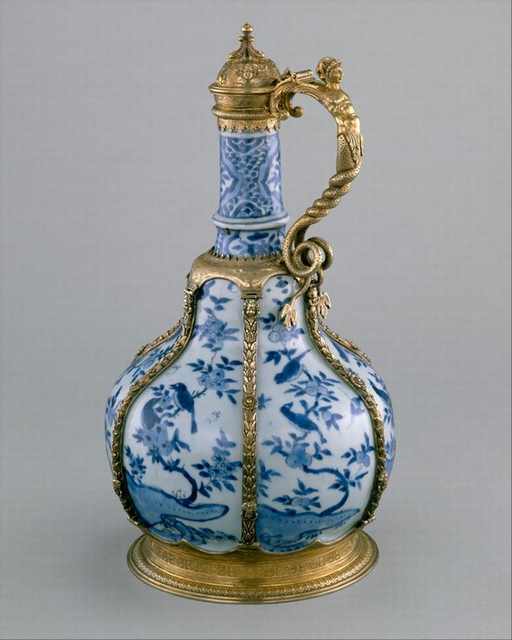 |
|
In
the sixteenth century Chinese porcelain was brought to England, where
it was considered a special treasure. The most accomplished English
silversmiths were often commissioned to make mounts for them, such as
this one. Pieces such as these were regarded as suitable gifts for the
royal family, or for the furnishing of their houses. |
|
The Coronation of the Virgin by Annibale Carracci - 1595 |
 |
|
Annibale
Carracci was the most influential painter of the seventeenth century
and a main figure in the development of classicism art style. This
picture was painted shortly after his arrival in Rome, in 1595. In it,
Annibale brought together two currents of Italian painting: a
sensitivity to the effects of natural light and color, and the spatial
organization and idealized figures from the Renaissance. |
|
Boiserie from the Hôtel de Varengeville - 1736, Paris - France
|
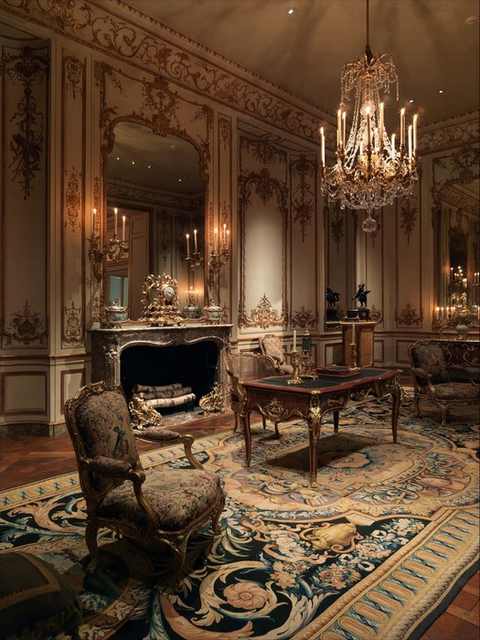 |
|
These
magnificent wall panels are decorated with superb carving of
long-necked birds, flowers and plants. They come from one of the private
residences of the Hotel de Varengeville, which still stands today, much
altered, at 217, boulevard Saint-Germain, Paris. |
|
Japanese Armor – Oldest part from 1688, Japan |
 |
|
This
example comes from the armory of Date Yoshimura (1703–1746), daimyo
(lord) of Sendai. The breastplate is inscribed with the armorer’s name,
Myōchin Munesuke (1688–1735) on the metal itself. Despite its ceremonial
appearance, it is also a very efficient set of armor. |
|
Cabinet- Ébéniste - 1867, Paris - France |
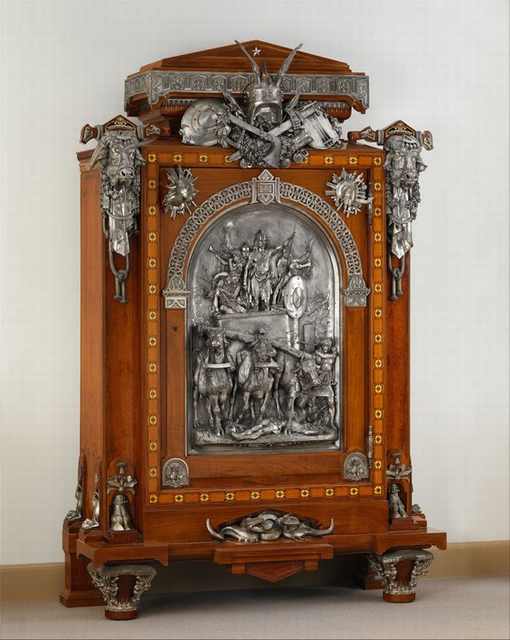 |
|
When
this compelling cabinet was exhibited for the first time in 1867 it
received mixed criticism. It is decorated with vivid and unsettling
representations of the military triumph of Merovech, leader of the
Salian Franks, over Attila the Hun, at the Battle of the Catalaunian
Field in 451. Merovech can be seen standing at the front of a chariot as
it passes over the dead bodies of his opponents. |
|
Afternoon dress – 1855, France |
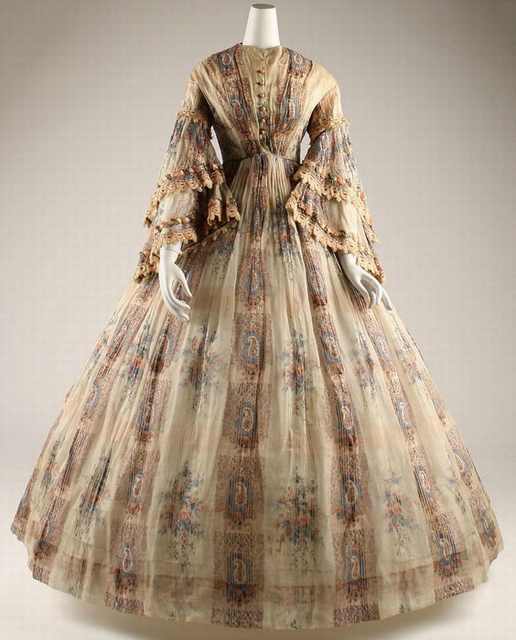 |
|
Nineteenth-century
gauze dresses like this one incorporate the romance of the buta motif
design in fabrics that bear no relation to the original Kashmiri wools.
It's hard to believe but this dress, with its multiple layers of wool
and features, was made for all seasons. While it was undoubtedly
beautiful, it couldn’t have been too comfortable… |
|
|
dimanche 31 août 2014
22 Highlights From the Metropolitan Museum of Art.
Inscription à :
Publier les commentaires (Atom)
Aucun commentaire:
Enregistrer un commentaire